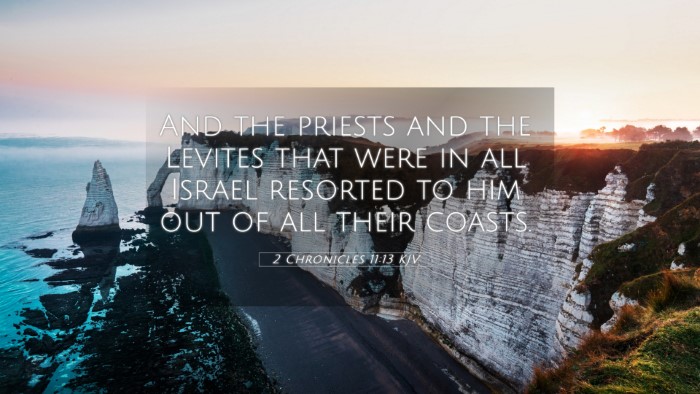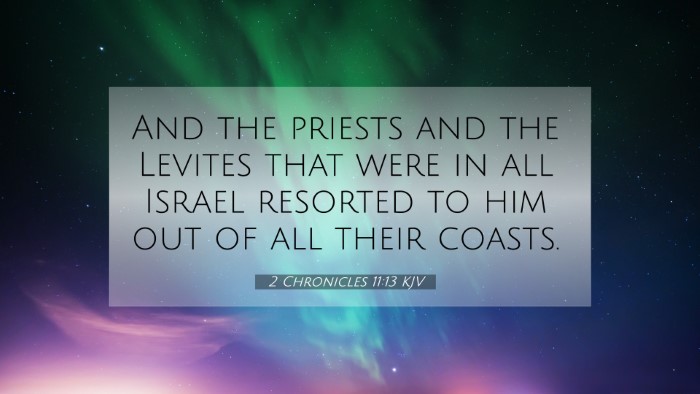Understanding 2 Chronicles 11:13
2 Chronicles 11:13 states: "And the priests and the Levites that were in all Israel resorted to him out of all their coasts." This verse highlights a significant moment during the reign of King Rehoboam, where many priests and Levites from the northern tribes came to Judah to follow him.
Contextual Analysis
Rehoboam, the son of Solomon, faced a critical junction in his reign as he ascended to the throne of David in Jerusalem. Following the division of the kingdom, key religious leaders responded to his call, denoting a major shift in the religious landscape of Israel.
Thematic Connections
Several themes interweave this moment, such as:
- Leadership and Authority: Rehoboam’s authority as king is challenged by the separation of the northern tribes.
- Religious Fidelity: The movement of priests and Levites indicates a yearning for proper worship.
- Divine Sovereignty: God’s hand guides circumstances in the realm of leadership and worship.
Bible Verse Cross-References
This verse connects with various other scripture passages that enrich its meaning:
- 1 Kings 12:1-24: The account of the division of Solomon's kingdom and the reaction of the people.
- 2 Chronicles 10: The context of Rehoboam’s decision-making that leads to the split.
- Ezra 1:5: The return of the exiles, echoing the call of those dedicated to God.
- Hebrews 7:11-14: Discusses the importance of the priesthood and its lineage.
- Exodus 32:29: Reflects on the importance of the Levitical priesthood in responding to God’s call.
- Luke 3:23-38: Traces the lineage of Jesus, showing the significance of Levites historically.
- 2 Chronicles 15:9: Highlights the return of the faithful and the role of leadership in worship.
Expository Insights
According to Matthew Henry, this movement underscores the loyalty of the Levites and priests, who valued true worship over tribal allegiance. They recognized Rehoboam as the legitimate king despite the civil unrest. Albert Barnes emphasizes the action as a deliberate choice to maintain religious integrity amidst division. Adam Clarke posits that their migration to Rehoboam indicates a definitive stance for the continuity of traditions established in Jerusalem.
Significance of the Priests and Levites
The priests and Levites had a distinct role in guiding worship and meditating between the people and God. Their shift to Judah exemplifies the importance of divine worship prevailing over political divisions. In the commentary of Henry, the idea arises that when traditional structures are questioned or with new governance, the faithful must decide where to stand.
Implications for Modern Readers
For those seeking a deeper understanding of scripture, this verse exemplifies the thematic connections within the Bible and how individuals or groups might respond to significant changes in leadership or doctrine. Enhanced understanding of such scriptures can be achieved through:
- Engaging with Bible Concordances: Tools that provide listings of motifs across scripture.
- Utilizing Cross-Reference Guides: Resources that systematically link verses.
- Interactive Bible Studies: Methods that encourage connecting themes and teachings.
Conclusion
In summary, 2 Chronicles 11:13 serves as a pivotal reminder of the importance of leadership, unity in worship, and the community of faith's response to divine calling. The integration of this verse within the broader narrative of scripture opens avenues for deeper thematic exploration, reinforcing the essence of maintaining fidelity in religious practice regardless of political developments.
Further Study
Readers are encouraged to explore the connections between various scriptures, especially considering how they inform one another throughout biblical history. The techniques for cross-referencing Biblical texts can illuminate these connections. For instance, examining how the Old Testament context shifts into New Testament themes can yield profound insights into the continuity of God’s plan and His faithfulness throughout generations.


